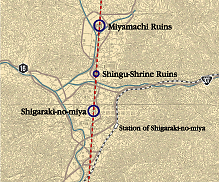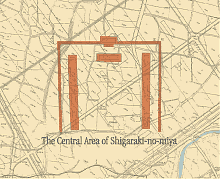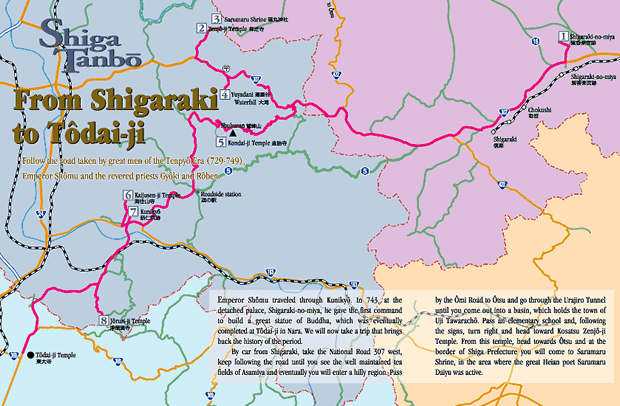
Shigaraki-no-miya

Site Plan of the Miyamachi Ruins
| Shigaraki-no-miya
Site Shigaraki-chô Kinose Walk 10 minutes from Shigaraki Kôgen Railway Shigaraki-no-miya Station. |

| 1 Shigaraki-no-miya | ||
 Shigaraki-no-miya |
 Site Plan of the Miyamachi Ruins |
|
| Once called the “Phantom Palace,”Shigaraki-no-miya, has been bathed in mystery. Recent excavations of this site, part of the Miyamachi ruins, has revealed the location of several buildings in addition to the previously-known West Hall. The discovery of three main palace buildings, including the East Hall of the Chôdô-in where national politics and rituals were conducted, has caused quite a stir. The layout of the buildings, with the Daian Hall on the central axis and side halls in parallel on either side, resembles that of Heijôkyô and other ancient palaces, showing that the Shigaraki Palace was a true center of government during the reign of Emperor Shômu from 729 to 749. Now that the central axis of the site has been determined, the existence of other buildings should be easy to confirm. | ||
| Further excavations here, along with those at the site of the Koga Temple, where it is supposed that the first framework for the Great Buddha was constructed in 744, a kilometer and a half to the south, should solve many mysteries of this period of history. | ||
|
||
| 2 Zenjô-ji Temple |  |
| The founding priest is said to have been Heisu, who was the head clerk at Tôdai-ji Temple in Nara. The central object of devotion is an Eleven-Faced Kannon. The main hall, with a thatched roof, has the feel of a mountain temple. The view of Uji Tawara from here is also beautiful. | |
| 3 Sarumaru Shrine | |
This shrine is dedicated to Sarumaru Dayu, who wrote
the famous poem, “Passing through reddened leaves, hear the cry of
a deer, the sadness of autumn.” The lively “Sarumaru Market”
occurs on the 13th of every month.
|
|
|
Leaving Sarumaru Shrine, return to the National Road 307 and go towards Shigaraki. Take a right before the post office and head on to Yuyadani where it is believed that a natural hot springs existed in the Tenpyô Era. This area is the home of Japanese green tea and has a strong connection with Nagatani Sôen. Pass through the village and follow the narrow road until you see the Yuyadani Waterfall. Seeing this clear water cascading through the deep valley is sure to refresh both your body and your heart. |
|
| 4 Yuyadani Waterfall | |
| At this waterfall, one among many coming off of the sacred peak Shubusan, the god of water is worshipped. |  |
|
|
|
Shubuzan has long been an important mountain for the ascetic practice, Shugendô, and the priests probably used to have to climb steep narrow paths. This time, though, we are traveling by car, so first return to National Road 307 and head east to the 283. Take your time to enjoy the beautiful cryptomeria trees on both sides of this road as you wind up the mountain. When you see the sign for Kontai-ji Temple, stop and walk about 7 minutes. At the top of the mountain the temple’s two-tiered pagoda, dedicated to two incarnations of Buddha, appears deeply still. Nearby is a grassy field with a great view of the town of Ujitawara a perfect place for a picnic. |
|
| 5 Kontai-ji Temple | |
| The great Shugendô priest En-no-Gyôja is reputed to have founded this temple. The imposing presence of the two-tiered pagoda, built in the Kamakura Period, is inspirational. |  |
|
|
| From Shubuzan head down toward Jifukudani and take the 62 toward Wazukacho until you reach the Michi-no-eki Chadokoro Wazukachô a rest stop on the corner of a large intersection. At this stop, there are restaurants serving noodles and other food, so this might be a good place for a snack. Take a right on to the Prefectural Road 5 at this intersection. In a way, this road joins the Iga Kaidô Road and at the next intersection you will see a large sign for Kaijusen-ji Temple. Shirasu Masako wrote about this temple in her book Eleven-Faced Kannon, “Recently, when I heard that a road had been built to the temple, I was relieved, but when I went there, the road was under repair and I had to walk after all.” If you can, drive up this road to the temple on the mountain, which also has a great view of the town of Kamo | |
| 6 Kaijusen-ji Temple | |
| This temple, which was founded by the priest Rôben at the decree of Emperor Shômu in 735, also has an Eleven-faced Kannon as its central image. To the left of the main gate is a beautiful five-tiered pagoda. |  |
|
|
| On the way down the mountain, before the Iga Kaidô Road, is the site of the Kunikyo Daigoku Hall and the Kokubunji Temple. All you will find of them now are stone markers showing their former locations, but in the spring you can enjoy cherry blossoms, in the summer fireflies, and in the fall cosmos flowers. From here, head straight toward Kamo Station and cross the Kuni Bridge. The Kizu River, which flows below, was once used to transport wood from the Koga and Iga regions as well as goods from Ômi. Imagine that materials used to make the Great Buddha once traveled down this same river. | |
| 7 Kunikyô Daigoku Hall and Kokubun-ji Temple Sites | |
| Kunikyô is known as the capital with the shortest use (740-744) in the history of Japan. After the capital was transferred elsewhere, it became one of the nationally-supported Kokubun-ji temples and was quite prosperous. |  |
|
|
| To get to Jôruri-ji Temple, go past the JR Kamo Station, cross the tracks and find yourself driving through the modern Minami Kamodai housing development. After going a little way, the scenery changes completely, becoming nostalgically inviting rustic fields. After climbing up a hill, you will see Jôruri-ji. Enjoy the view as you return to the Takada intersection from this temple. Take Route 44 to Umedaniguchi and you will be on the border of Nara, just a breath away from your final destination, Tôdai-ji. | |
|